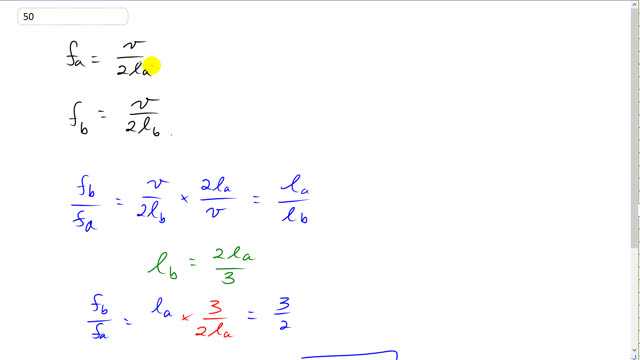
A violin string vibrates at 294 Hz when unfingered. At what frequency will it vibrate if it is fingered one-third of the way down from the end? (That is, only two-thirds of the string vibrates as a standing wave.)

In order to watch this solution you need to have a subscription.
This is Giancoli Answers with Mr. Dychko. The frequency of the fundamental in case a where there is no fingering happening no fingers pressed down on the neck of the violin, is the wave speed on the string divided by 2 times the length in this case. The length between the nut on the violin and the whatever the other end is called, between nodes anyhow. Where all the tuning keys are here. So, we have, and then the case b we have a string pressing down or finger pressing down the string so that it only goes from here to here. And this is being the neck of the violin here and the fingers pressing down here somewhere. And now the string has a new length lb instead of the original la. So, the frequency is gonna be different but the wave speed will be the same because it's the same string under the same tension and being the same string and has the same mass per length. And so the speed law of the standing wave along the string will be the same. So, we take frequency b divided by frequency a to find the ratio by which the different. And we have v over 2 lb, that's what frequency bis, we're gonna go multiply by the reciprocal of frequency a because dividing by a fraction is kind of confusing. So, we're going to multiply by its reciprocal instead and we see that the v's cancel and the 2's cancel and fb over fa is la over lb. Now, the length b is, this is the length if it's vibrating is 2/3 la over 3. So, sorry. 2/3 la. The finger is pressed down at a distance 1/3 from the tuning keys which leaves 2/3 of it vibrating. So, the length b is 2/3 length a. So, fb over fa is la divided by lb, we'll multiply it by its reciprocal. So, we'll multiply by 3 over 2 la. la's cancel, and that means fb over fa is 3 over 2. So, fb is 3 over 2 times fa. Multiply both sides by fa here. And that means the frequency b will be 3 over 2 times 294 hertz which is 441 hertz is our final answer.